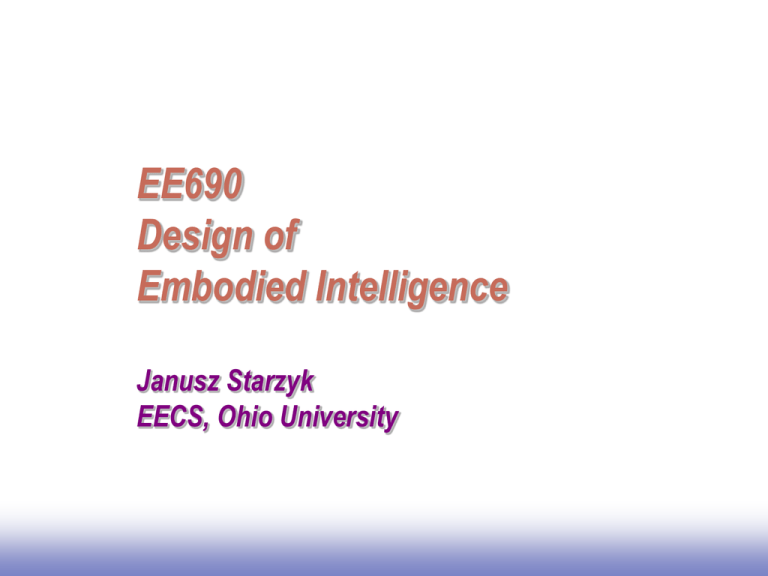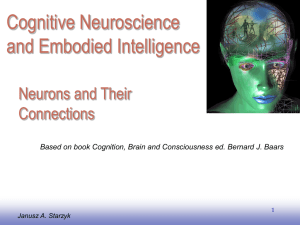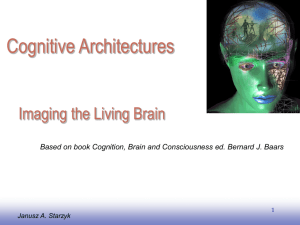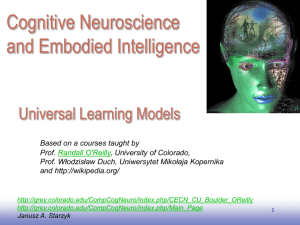Machine Intelligence
advertisement

EE690 Design of Embodied Intelligence Janusz Starzyk EECS, Ohio University EE141 Intelligence AI’s holy grail From Pattie Maes MIT Media Lab “…Perhaps the last frontier of science – its ultimate challenge- is to understand the biological basis of consciousness and the mental process by which we perceive, act, learn and remember..” from Principles of Neural Science by E. R. Kandel et al. E. R. Kandel won Nobel Price in 2000 for his work on physiological basis of memory storage in neurons. His family roots are in Kolomyje – so he once told “as with all bright people, my roots are in Poland” “…The question of intelligence is the last great terrestrial frontier of science...” from Jeff Hawkins On Intelligence. Jeff Hawkins founded the Redwood Neuroscience Institute devoted to brain research. He co-founded Palm Computing and Handspring Inc. EE141 Outline Traditional Artificial Intelligence Embodied Intelligence (EI) Challenges of EI We need to know how We need means to implement it We need resources to build and sustain its operation Promises of EI To economy To society EE141 Intelligence Mainstream Science on Intelligence December 13, 1994: An Editorial With 52 Signatories, History, and Bibliography by Linda S. Gottfredson, University of Delaware From http://www.indiana.edu/~intell/map.shtml EE141 Intelligence is a very general mental capability that, among other things, involves the ability to reason, plan, solve problems, think abstractly, comprehend complex ideas, learn quickly and learn from experience. Various Definitions of Intelligence The American Heritage Dictionary: The capacity to acquire and apply knowledge. The faculty of thought and reason. Webster Dictionary: The act or state of knowing; the exercise of the understanding. The capacity to know or understand; readiness of comprehension; Wikipedia – The Free Encyclopedia: The capacity to reason, plan, solve problems, think abstractly, comprehend ideas and language, and learn. The classical behavioral/biologists: The ability to adapt to new conditions and to successfully cope with life situations. Dr. C. George Boeree, professor in the Psychology Department at Shippensburg University: A person's capacity to (1) acquire knowledge (i.e. learn and understand), (2) apply knowledge (solve problems), and (3) engage in abstract reasoning. Stanford University Professor of Computer Science Dr. John McCarthy, a pioneer in AI: The computational part of the ability to achieve goals in the world. EE141 Traditional AI Abstract intelligence Embodied Intelligence attempt to simulate “highest” human faculties: knowledge is implicit in the fact that we have a body – language, discursive reason, mathematics, abstract problem solving Environment model Condition for problem solving in abstract way “brain in a vat” EE141 Embodiment – embodiment is a foundation for brain development Intelligence develops through interaction with environment Situated in a specific environment Environment is its best model Design principles of intelligent systems from Rolf Pfeifer “Understanding of Intelligence”, 1999 EE141 Interaction with complex environment cheap design ecological balance redundancy principle asynchronous parallel, loosely coupled processes sensory-motor coordination value principle Agent Drawing by Ciarán O’Leary- Dublin Institute of Technology Embodied Intelligence Definition Embodied Intelligence (EI) is a mechanism that learns how to survive in a hostile environment EE141 – Mechanism: biological, mechanical or virtual agent with embodied sensors and actuators – EI acts on environment and perceives its actions – Environment hostility is persistent and stimulates EI to act – Hostility: direct aggression, pain, anxiety or scarcity of resources – EI learns so it must have associative self-organizing memory – Knowledge is acquired by EI Embodiment of Mind Definition Embodiment of a mind is a mechanism under the control of the intelligence core that contains sensors and actuators connected to the core through communication channels. EE141 Embodiment Sensors Intelligence core Actuators Environment Embodiment of Mind Necessary for development of intelligence Hosts brain’s interfaces that interact with environment Not necessarily constant or in the form of a physical body Boundary transforms modifying brain’s self-determination EE141 Embodiment Sensors Intelligence core Actuators Environment Embodiment of Mind Brain learns own body’s dynamic Self-awareness results from identification with own embodiment Embodiment can be extended by using tools and machines Successful operation depends on correct perception of environment and own embodiment EE141 Motor cortex Somatosensory cortex Sensory associative cortex Pars opercularis Visual associative cortex Broca’s area Visual cortex Primary Auditory cortex Wernicke’s area Brain Organization EE141 While we learn its functions can we emulate its operation? How can we design intelligence? We need to know how We need means to implement it We need resources to build and sustain its operation EE141 Requirements for Embodied Intelligence State oriented Learns spatio-temporal patterns Situated in time and space Learning Perpetual learning Screening for novelty Value driven Goal creation Competing goals Emergence Artificial evolution Self-organization EE141 EI Interaction with Environment Agent Architecture Reason Short-term Memory Perceive Act RETRIEVAL LEARNING Long-term Memory INPUT OUTPUT Task Environment Simulation or Real-World System EE141 From Randolph M. Jones, P : www.soartech.com Challenges of Embodied Intelligence Development of sensory interfaces Active vision Speech processing Tactile, smell, taste, temperature, pressure sensing Additional sensing – Infrared, radar, lidar, ultrasound, GPS, etc. – Can too many senses be less useful? Development of reinforcement interfaces Energy, temperature, pressure, acceleration level Teacher input Development of motor interfaces Arms, legs, fingers, eye movement EE141 Challenges of Embodied Intelligence (cont.) Finding algorithmic solutions for Association, memory, sequence learning, invariance building, representation, anticipation, value learning (pain reduction), goal creation, planning Development of circuits for neural computing Determine organization of artificial minicolumn Self-organized hierarchy of minicolumns for sensing and motor control Self-organization of goal creation pathway EE141 Human Intelligence - Uniform Structure V. Mountcastle argues that all regions of the brain perform the same computational algorithm Groups of neurons (minicolumns) have the same structure and are connected in a pseudorandom way Minicolumns organized in macrocolumns VB Mountcastle (2003). Introduction [to a special issue of Cerebral Cortex on columns]. Cerebral Cortex, 13, 2-4. EE141 Selective Processing in Minicolumns Sensory inputs are represented by gradually more abstract features in the sensory hierarchy Use “sameness principle” of the observed objects to detect and learn feature invariance Learn to store temporal sequences Use random wiring to preselect sensory features Use feedback for input prediction and screen input information for novelty Use redundant structures of sparsely connected processing elements EE141 Interactions between Minicolumns Pleasure Positive Reinforcement Pain Value center Learn Sensory processing Direct Negative Reinforcement Control Motor processing Associate Sensory Inputs EE141 Motor Outputs Functions of Neurons in Minicolumns Sensory neurons are responsible for representing environment receive inputs from sensors or sensory neurons on lower level represent the environment receive feedback input from motor and higher level sensory neurons help to activate motor and reinforcement neurons Motor neurons are responsible for actions and skills are activated by reinforcement and sensory neurons activate actuators or provide an input to lower level motor neurons provide planning inputs to sensory neurons Reinforcement neurons are responsible for building the value system, goal creation, learning, and exploration EE141 receive inputs from reinforcement neurons on the lower level receive inputs from sensory neurons provide inputs to motor neurons initiate learning and force exploration Selective Sensory-Motor Pathways Hierarchical sensory and motor pathways Branching off from more general to more specific Easy to expand to higher levels Gradual loss of interconnect plasticity towards inputs inputs EE141 internal representations Selective Sensory-Motor Pathways Increasing connection’s plasticity Sensory pathway Sensory neurons in a minicolumn ………… 106 neurons 10 neurons 104 neurons EE141 Activation pathway 10 neurons 1011 neurons … Environment … …... Organization of Sensory-motor Pathways General characteristics: Function: Hierarchical structure Minicolumn processing Spatial and temporal association via interconnections and dual neurons Feedback connections Selective adaptation Invariant representation Anticipation Screening for novelty Value learning ... … ... … ... … EE141 Sensory-motor Coordination Goal creation &Value system Sensor path Motor path D … … R … … A R: representation E: expectation A: association D: direction P: planning EE141 Environment ’ adaptability Increasing connection’s E Goal Driven Behavior EE141 Goal driven behavior is one of the required elements of intelligence Perceptions and actions are activated selectively to serve the machine’s objectives In the existing EI models, the goal is defined by designers and is given to the learning agent Humans and animals create their own goals The goal creation may be one of the most important elements of EI mechanism Goal Creation EE141 Goals must be built and understood in a similar way to building perceptions More complex goals can be understood only if representations for these goals are build Goal creation should result from EI interaction with environment, by perceiving successes or failures of its actions Goal creation ability is essential for developing intelligence We will create goals based on simple structures interacting with sensory and motor pathways Pain-center and Goal Creation Simple Mechanism Dual pain level Pain increase Creates hierarchy of (-) + values (-) (+) Leads to formulation of complex goals (+) Reinforcement (+) (-) neurotransmitter: Pain level Pain decrease • Pain increase • Pain decrease Excitation Forces exploration EE141 Sensor Environment Motor Abstract Goal Creation The goal is to reduce the primitive pain level Abstract goals are created to satisfy the primitive goals Sensory pathway (perception, sense) Motor pathway (action, reaction) refrigerator Open - + food”becomes a “ sensory input to abstract pain center Abstract pain (Delayed memory of pain) Food Eat - Association Inhibition Reinforcement Connection Planning Expectation EE141 Level II Level I + Dual pain Pain Primitive Level Stomach The Three Pathways Combined Goal creation, sensory and motor pathways interact on different hierarchy levels Pain driven goal creation sets goal priorities The tree pathways emerge together from interaction with the environment Pain tree I Pain tree II Motor pathway Sensory pathway Pain center to motor Sensor to motor Sensor to pain center EE141 How can we design intelligence? We need to know how We need means to implement it EE141 Hardware self-organization Sparsity of interconnect Functionality requirements EI Design Efforts We need resources to build and sustain its operation We need means to implement it What is needed is a self-organizing hardware Saves design work Increases hardware reliability Improves production yield Lowers design cost Basic mechanism for self-organized hardware is pruning of random interconnections Nature does it Activity triggered “growth” of new neurons Spare neurons used in the later stages of learning EE141 We need means to implement it Brain is self-organizing and sparse Human Brain at Birth EE141 6 Years Old 14 Years Old Rethinking the Brain, Families and Work Institute, Rima Shore, 1997. Synaptic Density over the Lifespan Thompson, R. A., & Nelson, C. A. (2001). Developmental science and the media: Early brain development. American Psychologist, 56(1), 5-15. EE141 Sparse Connectivity The brain is sparsely connected. A neuron in cortex may have on the order of 100,000 synapses. There are more than 1010 neurons in the brain. Fractional connectivity is very low: 0.001%. Implications: Connections are expensive biologically. Short local connections are cheaper than long ones. EE141 Hierarchical Self-organizing Learning Memory (HSOLM) Feature extraction – using WTA Generalization – using overlapping regions winner h+1 … … h … … s … … … … r-lower level region (single WTA in each) EE141 Hierarchical Self-organizing Learning Memory 3-layer R-net in hierarchical structure Reduced connection density The winner pathway replaces the WTA Established using feed-back and local competition winner h+1 s2 … … … … number of output links from the lower level nodes s1 lo 3 nh1 (i 1, 2, ...nh (ns1, ns 2 )) h … Input pattern EE141 Self-Organizing Learning Arrays SOLAR EE141 Wiring in SOLAR Initial wiring and final wiring selection for credit card approval problem EE141 Associative SOLAR EE141 Sequence Learning Mechanism Multiple winner Detection Neuron Excitation link miss IR n1 mit mom n2 n3 1 2 3 4 1 2 3 4 1 2 3 4 1 2 3 4 1 2 3 4 s m i t o MUX MUX MUX MUX MUX TP LFN LN Preduction Neuron Prediction Matching Neuron EE141 PCN From ESN Software or hardware? Software Sequential Error prone Require programming Low cost Well developed programming methods EE141 Hardware Concurrent Robust Require design Significant cost Hardware prototypes hard to build Future software/hardware capabilities 11 10 10 10 g alo n A SI L V 9 Number of neurons 10 (F ch a ro pp a are w d r Ha 8 10 7 10 re tw a Sof 6 10 io u lat m i S Human brain complexity A) G P d) ase b C n (P 5 10 4 10 2005 2010 2015 2020 2025 Year EE141 2030 2035 2040 How can we design intelligence? We need to know how We need means to implement it We need resources to build and sustain its operation EE141 Major Intelligent Systems Design Efforts GOMS - Goals, Operators, Methods, and Selection Rules Proposed by Card, Moran, and Newell (1983), for modeling and describing human task performance SOAR - State, Operator, Application, Result Based on the book by Newell, A. (1990), Unified Theories of Cognition. ACT-R (Adaptive Control of Thought - Rational ) Described by Anderson, J. (1993), Rules of the Mind Artificial General Intelligence – Adaptive A.I. Inc. http://adaptiveai.com/ Hierarchical Temporal Memory – Numenta Inc. http://www.numenta.com/ 3DANN “Brain On Silicon” will not be just a science fiction! EE141 Irvine Sensors Corporation (Costa Mesa, CA) EI Design Efforts GOMS - Goals, Operators, Methods, and Selection Rules Inspired by psychology of immediate action Explicit hierarchical task decompositions Explicit pairing of goals with tasks Belief, Goal and Plan representation and selection Primary Engineering Activities Cognitive task analysis Design of goal hierarchy Definition of plans and selection rules Definition of primitive operators and resource constraints Proposed by Card, Moran, and Newell (1983), for modeling and describing human task performance EE141 From slide by Dan Glaser EI Design Efforts SOAR - State, Operator, Application, Result Problem space and physical symbols Minimal set of rules to support intelligent behavior Belief, Goal and Plan representation and selection Primary Engineering Activities Cognitive task analysis Identification of primitive operations Design of belief and goal hierarchies Design of situation interpretation hierarchies Interactions between knowledge units http://sitemaker.umich.edu/soar Newell, A. 1990. Unified Theories of Cognition. Cambridge, Massachusetts: Harvard University Press. EE141 EI Design Efforts ACT-R (Adaptive Control of Thought - Rational ): a cognitive architecture inspired by psychological models of memory, skills, and learning Optimization-oriented integrated memory, action, and learning Procedural knowledge units with explicit retrieval Uses if then production rules Belief, Goal and Plan representation and selection Primary Engineering Activities Cognitive task analysis Identification of procedural and declarative knowledge Design of semantic associations and retrievable goal hierarchies Identification of primitive operations with logical and associative context EE141 Anderson, John. Rules of the Mind, Lawrence Erlbaum Associates, Hillsdale, NJ (1993). EI Design Efforts Hierarchical Temporal Memory – Numenta Inc. Primary Engineering Activities Uses hierarchy of spatio-temporal associations Discover causes in the world Learns complex goal-oriented behavior Makes predictions while learning Combines unsupervised and supervised learning to make associations Aims at exceeding human level cognition Cognitive structure analysis Pattern learning in hierarchical memories Temporal sequence learning mechanism Goal creation Die Stack http://www.numenta.com/ Irvine Sensors Corporation (Costa Mesa, CA) EE141 EI Design Efforts Artificial General Intelligence – Adaptive A.I. Inc. Primary Engineering Activities Has general cognitive ability Acquires knowledge and skills Uses bidirectional, real-time interaction Selects information and uses an adaptive attention Unsupervised and self-supervised learning Adaptive and self-organizing data structure Processes dynamic patterns Explicitly engineering functionality Conceptual design General proof of concept Animal level cognition 3DANN http://adaptiveai.com/ “Brain On Silicon” will not be just a science fiction! EE141 Irvine Sensors Corporation (Costa Mesa, CA) How can we design intelligence? We need to know how We need means to implement it We need resources to build and sustain its operation EE141 Resources – Evolution of Electronics EE141 From Ray Kurzwail, The Singularity Summit at Stanford, May 13, 2006 EE141 By Gordon E. Moore EE141 Clock Speed (doubles every 2.7 years) EE141 From Ray Kurzwail, The Singularity Summit at Stanford, May 13, 2006 Doubling (or Halving) times EE141 Dynamic RAM Memory “Half Pitch” Feature Size Dynamic RAM Memory (bits per dollar) Average Transistor Price 5.4 years 1.5 years 1.6 years Microprocessor Cost per Transistor Cycle Total Bits Shipped Processor Performance in MIPS Transistors in Intel Microprocessors Microprocessor Clock Speed 1.1 years 1.1 years 1.8 years 2.0 years 2.7 years From Ray Kurzwail, The Singularity Summit at Stanford, May 13, 2006 Why should we care? EE141 Source: SEMATECH Design Productivity Gap Low-Value Designs? Percent of die area that must be occupied by memory to maintain SOC design productivity 100% 80% 60% % Area Memory 40% % Area Reused Logic 20% % Area New Logic 19 99 20 02 20 05 20 08 20 11 20 14 0% Source = Japanese system-LSI industry EE141 Biomimetics and Bio-inspired Systems Mission Complexity Impact on Space Transportation, Space Science and Earth Science 2002 2010 2020 2030 Embryonics Self Assembled Array Space Transportation Biologically inspired aero-space systems Sensor Web Brain-like computing Extremophiles Mars in situ life detector Skin and Bone Self healing structure and thermal protection systems EE141 Biological nanopore low resolution Artificial nanopore high resolution DNA Computing Biological Mimicking Nanosystems Revolutions in electronics and computing will allow reconfigurable, autonomous, "thinking" spacecraft Universal Joint http://ipt.arc.nasa.gov/nanotechnology.html NanoEngineer-1 is an Open Source (GPL) project sponsored by Nanorex, Inc. It is an interactive 3D nanomechanical engineering program Planetary Gear EE141 Nanorex Inc. From EE141 From Ray Kurzwail, The Singularity Summit at Stanford, May 13, 2006 Promises of embodied intelligence To society Advanced use of technology – Robots – Tutors – Intelligent gadgets Society of minds – Superhuman intelligence – Progress in science – Solution to societies’ ills To industry Technological development New markets Economical growth EE141 ISAC, a Two-Armed Humanoid Robot Vanderbilt University Transhumanist values Nothing wrong about “tampering with nature” Individual choice in the use of enhancement technologies; Peace, international cooperation, anti-proliferation of WMDs Improving understanding (research and public debate; critical thinking; open-mindedness; scientific progress; open discussion of the future) Getting smarter (individually; collectively; develop machine intelligence) Pragmatism; engineering and entrepreneur-spirit; “can-do” attitude Diversity (species, race, religious creed, sexual orientation, life style, etc.) Saving lives (life extension, anti-aging research, and cryonics) EE141 Copyright Institute for Ethics and Emerging Technologies 2004-2005 Sounds like science fiction If you’re trying to look far ahead, and what you see seems like science fiction, it might be wrong. But if it doesn’t seem like science fiction, it’s definitely wrong. From presentation by Feresight Institute EE141 EE141 Embodied Artificial Intelligence Based on: [1] E. R. Kandel et al. Principles of Neural Science, McGraw-Hill/Appleton & Lange; 4 edition, 2000. [2] F. Inda, R. Pfeifer, L. Steels, Y. Kuniyoshi, “Embodied Artificial Intelligence,” International seminar, Germany, July 2003. [3] R. Chrisley, “Embodied artificial intelligence, ” Artificial Intelligence, vol. 149, pp.131-150, 2003. [4] R. Pfeifer and C. Scheier, Understanding Intelligence, MIT Press, Cambridge, MA, 1999. [5] R. A. Brooks, “Intelligence without reason,” In Proc. IJCAI-91. (1991) 569-595 . [6] R. A. Brooks, Flesh and Machines: How Robots Will Change Us, (Pantheon, 2002). [7] R. Kurzweil The Age of Spiritual Machines: When Computers Exceed Human Intelligence, (Penguin, 2000). EE141







